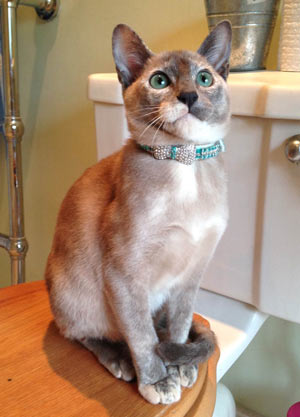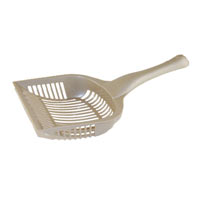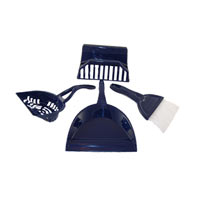Should I Toilet Train My Cat?

The short answer on whether or not you should train your cat to use your toilet is: probably not.
In the past few years, many cat owners have become curious about teaching their cat to urinate and defecate in their human toilet. However, you and your cat are almost sure to be better off using the tried and true litter box instead.
The Litter Box Is a Daily Feline Health Gauge
Scooping the litter box each day, as is necessary to keep your cat using it reliably, has another highly beneficial side effect: it allows you to frequently monitor key aspects of your cat's health. While the litter box contents certainly don't present a complete picture of your cat's health, they are nonetheless quite revealing and in some cases function as an "early warning system" for serious illnesses or stress-related problems.
When you perform your daily litter box chores, start off by taking a look at what's in the box. If the urine clumps are half-dollar-sized or smaller, or if the number of clumps is markedly higher than usual, your cat may be urinating with increased frequency. This could be a sign of a bladder infection or an early symptom of diabetes, kidney disease, or several other conditions. If you see any blood mixed in with the clumps, contact your veterinarian or after-hours clinic right away—your cat may be at risk for developing a dangerous urinary condition.
Note the consistency of the stools in the box, as well. They should be firm but not exceedingly hard and brittle. Stools that are too hard may indicate that your cat is constipated or dehydrated while soft stools are usually a sign that your cat has diarrhea. Both of these conditions can occur in healthy cats on an occasional basis, but persistent cases merit a consultation with your veterinarian.
Your cat's stools should be dark brown in color. A departure from this that goes on for more than a day could mean anything from poor diet to liver disease. If there is any blood in the stool, your cat may have bleeding in the lower digestive tract.
Once you incorporate the monitoring of litter box contents into your daily routine, you will become quite proficient at recognizing what's normal for your cat and at noticing anything out of the ordinary.
If you live with many cats, it's more challenging to interpret litter box contents, but doing so is still valuable. Even knowing that one cat is off-kilter on his or her litter box usage can be a great advantage. You can then separate your cats with individual litter boxes to determine which one has the problem.
The value of being able to examine your cat's litter box output should not be underestimated. You lose this daily health check when your cat uses a toilet instead of a litter box.
Cats Naturally Use the Litter Box
In the wild, the vast majority of cats cover or bury their waste to mask the odor and remain stealthy. Cats learn to use the litter box from their mother (or, if orphaned, from a surrogate "mother" at the animal shelter) when they're a young kitten, building on their innate predisposition to scratch and conceal their excrement. Some cats will leave their urine and feces exposed as a way to assert dominance, but this situation is rare among spayed or neutered cats living in a house where food is plentiful and territory is secure. If your cat does exhibit this behavior, toilet training is unlikely to stop it and may actually complicate matters.
So "dig and cover" is a cat's natural tendency. You just don't see cats in the wild positioning themselves over a stream or hole to relieve themselves. There is always a risk in trying to get a cat to act in a way that is a departure from his normal routine. He may feel stressed and begin exhibiting negative behaviors such as scratching inappropriately, eliminating inappropriately, or acting aggressively. Why bother risking it when there is no benefit to the cat? Even a gradual transition to using the toilet could increase your cat's stress, and that is something you certainly don't want to do; once a cat is eliminating inappropriately, it can be a difficult thing to reverse.
Additional Problems with Toilet Training Cats
Aside from the potential health and behavior concerns with cats not using a litter box, there are some other possible logistical issues that may come up.
- Visitors and guests may be quite surprised to be sharing the bathroom with a cat or to notice that a cat has recently used the toilet and forgotten to flush.
- Family members and guests have to remember to keep the bathroom door open and the toilet seat up. Sometimes this is less practical than other times.
- You don't want to get your cat out of the habit of using the litter box. If he ever needs to be boarded or stay at the veterinary clinic, he has to use a litter box. Likewise, if he is ever recovering from an injury or surgery, using the toilet will most likely be out of the question.
What If My Cat Uses the Toilet on His Own?
Cats are nothing if not individuals. A few cats actually use the toilet (or attempt to) without any coaxing or training from a human. Be aware that, in some of these instances, there may be underlying, preventable reasons for the cat's preferences that should be investigated. If your cat decides independently to use the toilet, he may be somewhat less prone to suffer stress from engaging in this unusual mode of eliminating, but it's still a behavior you should discourage, for the reasons discussed above.
Cleaning the Litter Box Is Not That Difficult
From a purely practical standpoint, cats are renowned for being easy to take care of relative to other pets. The fact that cats can use a litter box is often cited as one of their most attractive "ease of maintenance" features. Whether you prefer a high-tech automatic litter box or an old-fashioned, reliable, simple plastic one; whether you use clumping litter, pine litter, or crystal litter
, scooping a litter box takes less than five minutes. Cleaning it and replacing the litter every week or two takes about 10 minutes. You can learn more in the article "Tips for Good Litter Box Cleaning."
In other words, keeping the litter box fresh and clean is not a particularly burdensome or time-consuming task. It facilitates your cat's natural motivation to cover his waste, provides you with an opportunity to track your cat's health, and is pretty easy. Toilet training a cat can be risky business.
If It Ain't Broke, Don't Fix It. If It Is Broke, Use the Right Tools to Fix It
Under normal circumstances, a cat will develop proper litter box habits as a kitten and faithfully use the litter box his whole life. If your cat is in this category, don't mess with success; you've got a good thing going.
If your cat is avoiding the litter box, you need to determine why by ruling out medical causes and exploring possible stress and/or litter box environment factors, and then take appropriate corrective action. Attempting to toilet-train your cat in the middle of your rehabilitation efforts would be ill-advised. You can learn more here: "Cat Not Using Litter Box? Inappropriate Urination in Cats."




You May Also Like These Articles:
Tips for Good Litter Box Cleaning
Clicker Training for Cats: An Overview
Five Reasons Cats Urinate Outside of the Litter Box
Cat Not Using Litter Box? Inappropriate Urination in Cats
Tips for Good Litter Box Placement
General Tips for Solving Inappropriate Urination Problems in Cats
Tips for Avoiding Litter Aversion in Cats
Cat Spraying: Feline Marking Behavior





